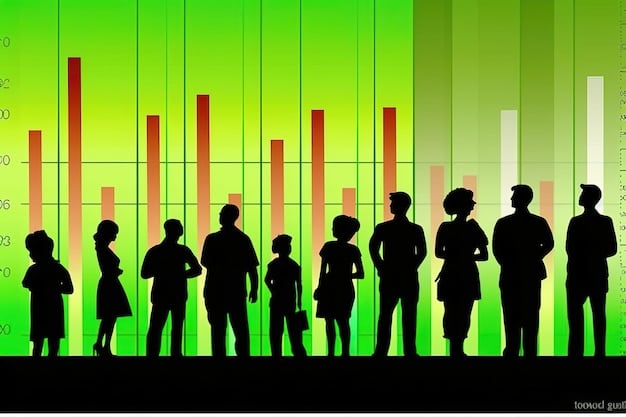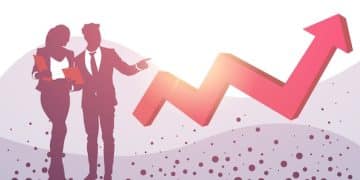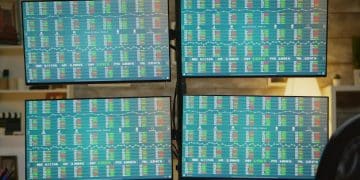US Unemployment Rises to 5%: Impact on Labor Market

The recent 5% increase in the US unemployment rate signals a pivotal shift in the labor market, potentially indicating a softening economy and prompting crucial adjustments for both job seekers and policymakers.
The latest financial report has delivered significant news: the US unemployment rate has climbed to 5%. This figure, while seemingly contained, carries substantial implications for the nation’s labor market, influencing everything from hiring trends to consumer confidence. Understanding the nuances of this shift is crucial for anyone navigating the current economic landscape.
Understanding the Latest Unemployment Data
The recent announcement of the US unemployment rate rising to 5% has naturally sparked considerable discussion among economists, policymakers, and the general public. To fully grasp the significance of this figure, it’s essential to look beyond the raw percentage and delve into the underlying data and what it truly represents for the workforce. This involves understanding the methodology used in calculating unemployment and how various segments of the population are affected.
The Bureau of Labor Statistics (BLS) compiles unemployment data through extensive surveys, primarily the Current Population Survey (CPS). This survey gathers information from thousands of households across the nation to determine labor force status, including employment, unemployment, and not in the labor force. A person is considered unemployed if they are jobless, currently available for work, and had actively looked for work in the prior four weeks. This strict definition helps differentiate between those who are genuinely seeking employment and those who are voluntarily out of the workforce.
When the rate shifts from, say, 4.8% to 5%, it signifies that a notable number of people previously engaged in employment, or actively seeking it, are now classified as unemployed. This could be due to various factors, such as layoffs, business closures, or a slowdown in hiring activity across multiple sectors. Conversely, a stable or decreasing unemployment rate often indicates a robust job market where opportunities are abundant and joblessness is minimal. The 5% mark itself is not necessarily alarming in isolation, as historical context reveals periods of higher and lower rates. However, the trajectory and the speed of the increase are what often capture attention.
Seasonal Adjustments and Real Figures
Unemployment data is frequently adjusted for seasonal variations to provide a clearer picture of underlying trends. For instance, industries like retail or construction often experience predictable fluctuations in employment throughout the year due to seasonal demand. Without these adjustments, the raw numbers might create a misleading impression of the economy’s health. Therefore, the reported 5% rate is most likely a seasonally adjusted figure, aiming to reflect the true state of the labor market independent of regular seasonal patterns. This standardization allows for more accurate comparisons over time and across different economic cycles.
- Understanding seasonal adjustments helps distinguish between temporary shifts and long-term trends.
- The reported 5% rate often reflects sophisticated statistical adjustments.
- Unadjusted figures can offer insights into specific industry or regional impacts.
Which Sectors Are Most Affected?
A broad unemployment rate increase often conceals varying impacts across different economic sectors. While some industries might experience significant job losses, others might remain relatively stable or even grow. Identifying these specific sectors is crucial for understanding the granular implications of the rate increase and for anticipating future economic shifts. For example, sectors heavily reliant on consumer spending, such as hospitality or retail, might be among the first to feel the pinch during an economic slowdown, leading to increased layoffs. Conversely, sectors like healthcare or technology might exhibit more resilience, depending on their specific market dynamics and underlying demand.
The 5% unemployment rate signifies a broader softening, but its impact is rarely uniform. Analyzing sub-sectors helps reveal where the economic pressure points truly lie. This allows for targeted policy responses and better resource allocation. For example, understanding if manufacturing or service industries are disproportionately affected can inform decisions about retraining programs or unemployment benefits, directly assisting those most in need. Additionally, the labor market’s response to interest rate changes often varies by sector, making this detailed analysis even more pertinent for economic forecasting. This kind of granular insight from the BLS reports is critical for economists and policy makers to design effective interventions and support programs.
Immediate Impacts on the Labor Market
The shift to a 5% unemployment rate does not happen in a vacuum; it triggers a series of immediate reactions and adjustments within the labor market. These impacts can be felt by employers and job seekers alike, influencing everything from hiring processes to wage negotiations and overall job security. Understanding these immediate consequences is essential for both businesses strategizing their workforce needs and individuals planning their career paths.
For job seekers, an elevated unemployment rate generally means increased competition for available positions. When more people are actively looking for work, the pool of applicants for each job opening expands, making it harder for individuals to stand out. This can lead to longer job search durations and a potential reduction in bargaining power regarding salaries and benefits. Companies, on the other hand, might find themselves in a more favorable position to attract top talent due to the larger candidate pool. However, this also means they might face an increased administrative burden in sifting through a higher volume of applications, necessitating more robust recruitment strategies.
Increased Competition for Jobs
The direct effect of a rising unemployment rate is a significant increase in the number of individuals vying for each open position. This heightened competition can be particularly pronounced in certain industries or roles, especially those that are perceived as stable or desirable. Job seekers may find themselves applying to dozens or even hundreds of roles before securing an interview, and the interview process itself might become more rigorous and drawn out. This environment necessitates that applicants refine their resumes, enhance their skill sets, and network more aggressively to differentiate themselves from the larger pool of candidates. For employers, while they might have a larger selection, identifying the truly best fit can become a more complex task.
- Job applications per opening may significantly increase.
- Candidates might need to enhance their skills to remain competitive.
- Networking becomes even more critical for job seekers.
Wage Stagnation or Decreases
When the supply of labor outweighs the demand, the natural economic consequence is a downward pressure on wages. In an environment of rising unemployment, employers may feel less compelled to offer competitive salaries or significant raises, as there is a larger pool of individuals willing to accept existing terms. This can lead to wage stagnation across various sectors, impacting the purchasing power of consumers and potentially slowing economic growth. For those currently employed, the fear of job loss might reduce their leverage in negotiating salary increases, as companies may be less inclined to meet higher demands when alternatives are readily available. This dynamic can have broader implications for household incomes and overall economic stability, as disposable income may shrink.
Furthermore, new hires might find entry-level salaries lower than expected, reflecting the increased competition and reduced employer strain to attract talent. This situation can be particularly challenging for recent graduates or those switching careers, who might have less experience to leverage in negotiations. The ripple effect of wage stagnation can extend to the broader economy, as reduced consumer spending can further dampen demand for goods and services, potentially creating a feedback loop of economic slowdown. Therefore, addressing wage pressures becomes an important consideration for policymakers aiming to stabilize the labor market and support economic recovery during periods of elevated unemployment.
Broader Economic Ramifications
An increase in the unemployment rate, particularly one reaching 5%, extends its influence far beyond individual job seekers and specific industries. It sends ripples throughout the entire economy, affecting consumer spending, business investment, and government fiscal policy. These broader economic ramifications are interconnected and can create a complex web of challenges and adjustments that policymakers and businesses must navigate carefully.
One of the most immediate and significant impacts is on consumer confidence and spending. When people are uncertain about their job security or the future of the economy, they tend to reduce discretionary spending and increase savings. This slowdown in consumer demand can hit businesses hard, leading to decreased revenues, reduced production, and potentially further layoffs, creating a negative feedback loop. Moreover, a higher unemployment rate also impacts government finances through increased social welfare expenditures, such as unemployment benefits, and reduced tax revenues from wages, which can strain public budgets. This situation often leads to a reevaluation of public spending priorities and potential fiscal adjustments.

Impact on Consumer Spending and Confidence
Consumer spending is a major driver of economic growth, and a rising unemployment rate can severely dampen it. When individuals face job insecurity or unemployment, they naturally become more cautious with their finances. This manifests as a reduction in non-essential purchases, a delay in major investments like homes or cars, and a general tightening of household budgets. The decline in consumer confidence creates a ripple effect: businesses see reduced demand, leading to lower sales, decreased profits, and, in some cases, further layoffs. This downward spiral can exacerbate economic slowdowns, making recovery more challenging. Policymakers often look for signs of consumer confidence rebound as a key indicator of economic recovery, as robust spending is vital for sustained growth.
- Reduced spending on non-essential goods and services.
- Delays in major household investments like real estate or automobiles.
- Increased savings as a precautionary measure against economic uncertainty.
Government Policy Responses and Fiscal Strain
A higher unemployment rate places considerable strain on government resources, necessitating policy responses aimed at mitigating the economic impact. Governments typically face increased demand for unemployment benefits, welfare programs, and other social safety nets, which directly increase public expenditures. Simultaneously, reduced employment means lower income tax revenues and potentially lower sales tax revenues, creating a fiscal squeeze. In response, governments might consider various strategies such as fiscal stimulus packages, investments in infrastructure to create jobs, or adjustments to monetary policy in coordination with central banks. These interventions aim to re-stimulate demand, support affected industries, and provide a safety net for those who have lost their jobs, although they often come with their own set of fiscal challenges and debates about their long-term effectiveness.
The effectiveness of these government responses is often debated, as there are trade-offs involved, such as increasing national debt or potential inflationary pressures from stimulus. For example, while unemployment benefits cushion the blow for individuals, they are a significant cost for the state. Governments must balance the need to support the unemployed and stimulate the economy with the imperative of fiscal responsibility. The policy choices made during periods of elevated unemployment have lasting consequences for national debt levels and economic structure. Therefore, understanding the interplay between unemployment, fiscal strain, and government intervention is critical for assessing the overall economic health and future trajectory of a nation during such challenging times.
Industry-Specific Analysis
While a 5% unemployment rate indicates a broad economic trend, its impact is rarely uniform across all sectors. Different industries behave distinctly, reacting to economic shifts based on their inherent characteristics, reliance on consumer spending, and susceptibility to global supply chains. A deep dive into industry-specific analyses reveals varying degrees of resilience and vulnerability, offering a more nuanced understanding of where the current economic pressures are most keenly felt and which sectors might lead or lag in recovery.
For instance, some industries, such as technology or healthcare, might demonstrate greater resilience due to ongoing demand for their services, or less sensitivity to immediate economic fluctuations. Conversely, sectors like manufacturing, retail, or hospitality often bear the brunt of economic downturns more severely, as they are directly tied to consumer discretionary spending or global trade dynamics. This divergence implies that a uniform policy response might not be sufficient; instead, tailored approaches are often necessary to support specific industries and their unique labor market challenges. Understanding these distinctions is paramount for effective economic forecasting and policy development, guiding resource allocation to areas where it can have the most significant impact on employment stability and recovery.
Manufacturing and Resource Sectors
The manufacturing and resource sectors are often considered bellwethers of economic health, as they are highly sensitive to both domestic and international demand, as well as global supply chain disruptions. An increase in the unemployment rate can signal a downturn in these sectors, often driven by reduced consumer demand for goods, decreased business investment, or shifts in international trade policies. For example, if consumer spending on durable goods declines, factories might scale back production, leading to layoffs in manufacturing plants. Similarly,
fluctuations in commodity prices or global demand can affect the mining and energy sectors, leading to job cuts. These industries are also capital-intensive, meaning that delayed investment decisions during uncertain economic times can have a prolonged impact on their employment levels. Therefore, a rising unemployment rate can reflect deeper issues within these foundational economic pillars, indicating a need for strategies that address both supply and demand sides of the economy.
- Global supply chain disruptions significantly impact production and employment.
- Declining consumer demand for goods directly affects factory output.
- Commodity price volatility influences employment in mining and energy sectors.
Service Industries and Retail Trends
Service industries and retail are heavily dependent on consumer confidence and disposable income, making them particularly vulnerable to rising unemployment. When job insecurity increases, people tend to cut back on non-essential services such as dining out, travel, entertainment, and luxury retail purchases. This immediate reduction in discretionary spending directly impacts businesses in these sectors, potentially forcing them to reduce staff, delay hiring, or even close down. Small businesses, which often make up a significant portion of the service and retail landscape, are especially susceptible due to their smaller cash reserves and limited ability to absorb financial shocks. The “domino effect” of reduced consumer spending in these areas can amplify the overall economic slowdown.
Moreover, the rise of e-commerce has been reshaping the retail landscape independently of economic cycles, and a general economic downturn can accelerate shifts towards online purchasing, further pressuring traditional brick-and-mortar retail establishments. For many service workers, flexibility and part-time employment are common, making them more vulnerable to shifts in demand, as businesses can quickly adjust staffing levels. Therefore, the 5% unemployment rate likely reflects significant job shedding or hiring freezes in these consumer-facing sectors, highlighting the need for targeted support to sustain these critical components of the economy and support the livelihoods of their employees.
Potential Long-Term Implications
While immediate impacts of a rising unemployment rate are evident, considering its long-term implications is equally critical. A sustained period of elevated unemployment can lead to structural changes within the labor market and broader society, affecting everything from workforce skills to social cohesion. These long-term consequences are often more subtle but can leave lasting marks on an economy and its population, influencing future economic trajectories and policy decisions for years to come.
One of the most significant long-term effects is the erosion of skills for those who experience prolonged unemployment. When individuals are out of work for extended periods, their professional skills can become outdated, and their networks diminish, making it harder to re-enter the workforce even when conditions improve. This can lead to a rise in long-term unemployment, which is particularly challenging to address. Furthermore, sustained high unemployment can contribute to social inequality, as vulnerable groups are often disproportionately affected. It can also lead to reduced innovation, as fewer new businesses are started, and existing ones become more risk-averse. Understanding these potential lasting changes is crucial for proactive policymaking aimed at fostering a more resilient and equitable economic future.
Scarring Effects on the Workforce
Economists often refer to “scarring effects” when discussing the long-term consequences of unemployment. This phenomenon describes how periods of unemployment can leave lasting negative impacts on individuals’ career trajectories, earning potential, and even mental health. Those who experience job loss, especially for extended periods, may struggle to regain employment at their previous skill or wage level, even after the economy recovers. Their skills might depreciate, their professional networks weaken, and potential employers might view gaps in employment unfavorably. This can lead to reduced lifetime earnings, increased career instability, and a widening of income inequality. For younger individuals entering the workforce during an economic downturn, these scarring effects can be particularly pronounced, making it harder for them to establish a firm foothold in their chosen careers and achieve their full earning potential over time.
Beyond individual impacts, scarring effects also have broader societal consequences. A workforce with a significant portion of underemployed or marginalized individuals can hinder overall productivity and innovation. The accumulation of these individual setbacks can contribute to a less dynamic labor market, reducing the economy’s ability to adapt to new technologies or changing global demands. Therefore, addressing the potential for scarring effects through proactive measures such as retraining programs, mentorship opportunities, and targeted employment support is not just about aiding individuals but also about preserving the long-term health and competitiveness of the entire economy. It emphasizes the importance of swift and effective interventions during periods of rising unemployment to mitigate these enduring impacts.
Changes in Business Investment and Innovation Cycles
Increased unemployment and the general economic uncertainty that often accompanies it can significantly alter business investment patterns and the pace of innovation. Companies tend to become more cautious, delaying expansion plans, reducing capital expenditures, and becoming less willing to invest in new technologies or research and development. This risk aversion is a natural response to reduced consumer demand and uncertain future revenues. A slowdown in business investment can have long-term consequences for economic growth, as it reduces the creation of new jobs, stifles productivity improvements, and weakens a nation’s competitive edge in the global marketplace. Innovation, which thrives on investment and risk-taking, can also slow down, potentially delaying breakthroughs and the emergence of new industries.
- Businesses often postpone new hiring and expansion plans.
- Reduced capital expenditures lead to slower technological upgrades.
- Lower investment in R&D can stifle future innovation.
Strategies for Individuals and Businesses
Navigating a labor market characterized by a 5% unemployment rate requires proactive strategies from both individuals and businesses. For job seekers, this means enhancing their competitiveness and adapting their approach to a more challenging environment. For employers, it involves refining talent acquisition strategies, focusing on retention, and potentially re-evaluating workforce planning in the face of economic uncertainty. Implementing thoughtful strategies can help mitigate the negative impacts of a softer job market and position both parties for greater resilience and success.
Individuals should prioritize skill development, strategic networking, and financial preparedness. Acquiring new, in-demand skills can make a significant difference in a competitive job market, while expanding one’s professional network can open doors to unadvertised opportunities. Building an emergency fund provides a crucial safety net during periods of unemployment. Businesses, conversely, need to focus on optimizing their existing workforce, considering upskilling current employees instead of solely relying on external hires. They should also maintain clear communication with employees to boost morale and reduce anxiety. These dual approaches are essential for creating a more adaptive and resilient labor force and business environment in the face of economic shifts.
Advice for Job Seekers
In a job market with a 5% unemployment rate, job seekers must adopt a proactive and strategic approach to stand out. The first step involves refining one’s resume and cover letter to highlight highly relevant skills and experiences. Tailoring each application to the specific job description is crucial, rather than sending generic applications. Networking remains paramount; leveraging professional connections, attending industry events, and utilizing platforms like LinkedIn can uncover opportunities not publicly advertised. Additionally, investing in continuous learning and skill development, particularly in areas with growing demand, can significantly boost employability. This could involve online courses, certifications, or even volunteer work to gain new experiences. Finally, maintaining a positive mindset and resilience is key, as job searches in a tougher market can often be prolonged and emotionally challenging.
- Tailor resumes and cover letters for each specific job application.
- Actively network and leverage professional connections.
- Invest in continuous skill development and relevant certifications.
Strategies for Employers
Employers facing a 5% unemployment rate and potential economic headwinds need to adjust their workforce strategies thoughtfully. While a larger talent pool might be available, attracting and retaining the right talent still requires strategic effort. Focusing on employee retention through competitive benefits, positive work culture, and opportunities for professional development can reduce turnover costs and maintain institutional knowledge. For new hires, employers might consider more rigorous screening processes to ensure optimal fit and long-term commitment. Furthermore, investing in upskilling and reskilling existing employees can be a cost-effective alternative to external hiring, ensuring that the current workforce has the necessary skills for evolving business needs. Finally, maintaining financial stability and transparent communication with employees about the company’s outlook can help build trust and mitigate anxiety within the workforce during uncertain times.
Businesses that prioritize flexibility, such as offering remote work options or flexible schedules, may also find themselves more attractive to top talent, even in a competitive market. This adaptability can enhance employee satisfaction and productivity, contributing to overall organizational resilience. Additionally, proactive financial planning, including managing cash flow and optimizing operational efficiencies, becomes even more critical to ensure the business can weather potential economic storms. Employers who strategically leverage workforce development and maintain a strong internal culture are better positioned to navigate the challenges presented by an evolving economic landscape, ensuring both immediate stability and long-term growth by retaining valuable human capital.
Future Outlook and Predictions
Forecasting the future of the labor market after a rise in the unemployment rate to 5% involves analyzing a complex interplay of economic indicators, policy decisions, and global events. While precise predictions are challenging, economists often use current trends, historical data, and various models to project potential scenarios. The outlook will largely depend on whether this increase is a temporary blip or the beginning of a more sustained upward trend, and how quickly various mitigating factors can come into play.
Key factors to watch include inflation rates, interest rate decisions by central banks, geopolitical stability, and global demand for goods and services. A persistent rise in inflation might compel central banks to continue tightening monetary policy, which could further dampen economic activity and potentially lead to more job losses. Conversely, if inflationary pressures ease, there might be room for more accommodative policies that could stimulate job growth. The speed of recovery in consumer confidence and business investment will also be crucial. Ultimately, the trajectory of the 5% unemployment rate will be a key barometer of broader economic health, reflecting the effectiveness of policy responses and the resilience of various market sectors. Continuous monitoring of these variables is essential for understanding the evolving landscape.
Economic Models and Projections
Economists rely on various models and data sets to project future unemployment rates and the broader economic outlook. These models consider factors such as GDP growth, inflation, consumer spending, business investment, and global economic conditions. While no model is perfect, they provide valuable insights into potential trajectories and highlight key sensitivities. For instance, some models might predict a stabilization of the unemployment rate if specific fiscal stimuli are introduced, while others might project further increases if interest rates continue to climb. These projections often come with a range of possibilities, reflecting the inherent uncertainties in economic forecasting. Analyzing these diverse models helps policymakers prepare for different scenarios and formulate adaptive strategies to support the labor market.
- GDP growth rates are primary inputs for unemployment forecasts.
- Inflation and interest rate trajectories significantly influence economic models.
- Global economic conditions and trade policies play a crucial role in long-term projections.
Potential for Recovery and New Opportunities
Despite the current rise in unemployment, there remains significant potential for recovery and the emergence of new opportunities within the labor market. Economic downturns, while challenging, often act as catalysts for innovation and efficiency improvements. Businesses that survive and adapt might emerge stronger, leaner, and more competitive. New industries or technologies can also gain traction during these periods, creating fresh demand for different skill sets. For example, a focus on green energy, artificial intelligence, or specialized healthcare services could lead to new job growth, even as traditional sectors adjust. Government investments in infrastructure or emerging technologies could also stimulate demand and create employment opportunities in areas previously underserved. The ability of the economy to pivot and create these new avenues for employment will be critical for a robust recovery, transforming challenges into opportunities for future growth and a more resilient workforce.
This period might also be an ideal time for individuals to reskill or upskill, preparing for the jobs of tomorrow. Educational institutions and training programs often respond to market needs, offering courses that align with emerging industry demands. For example, if there’s an anticipated boom in digital transformation roles, various online platforms might offer certifications in data science or cybersecurity. These proactive measures from both the supply and demand sides of the labor market can accelerate recovery and contribute to a more dynamic employment landscape. Therefore, while the 5% unemployment rate presents immediate challenges, it also sets the stage for strategic adaptation and future growth, emphasizing the cyclical nature of economic fluctuations and the continuous evolution of the workforce. The key lies in identifying and seizing these new opportunities as the economy transitions.
| Key Aspect | Brief Impact |
|---|---|
| 📊 Unemployment Rate | Rises to 5%, signaling a softening labor market and potential economic slowdown. |
| 💼 Job Competition | Increases significantly, making job search more challenging for individuals. |
| 🛒 Consumer Spending | Likely to decrease as confidence drops, impacting retail and service sectors. |
| 🌱 Long-term Outlook | Potential for scarring effects on workforce but also new opportunities through adaptation. |

Frequently Asked Questions
▼
A 5% unemployment rate indicates a measurable softening in the labor market. While not inherently catastrophic, it suggests that the economy may be slowing down, leading to increased job competition, potential wage stagnation, and reduced consumer confidence. This figure often prompts a re-evaluation of economic policies to prevent further decline and stimulate job growth, highlighting an important shift in economic equilibrium.
▼
A rising unemployment rate typically leads to an immediate decrease in consumer spending. When individuals face job insecurity, they tend to reduce discretionary purchases and save more as a precautionary measure. This impacts sectors like retail, hospitality, and entertainment, as businesses experience lower demand, potentially leading to further layoffs. Overall consumer confidence also drops, creating a negative feedback loop for economic growth.
▼
Yes, the impact of a rising unemployment rate is rarely uniform across all industries. Sectors heavily reliant on consumer discretionary spending, such as retail, tourism, and hospitality, are often among the first and most severely affected. Manufacturing and construction might also see declines due to reduced investment. Conversely, essential services like healthcare, utilities, and some technology sectors might show more resilience, depending on the specifics of the economic slowdown.
▼
Long-term implications of elevated unemployment include “scarring effects,” where individuals face reduced lifetime earnings and career instability due to extended joblessness. It can also lead to skill erosion, increased social inequality, and a slowdown in overall economic innovation and productivity as businesses delay investments. These effects can persist even after the economy recovers, influencing the future structure and health of the labor market.
▼
Individuals can mitigate impact by focusing on skill development, strategic networking, and building emergency savings. For businesses, strategies include optimizing existing workforce capabilities, investing in reskilling current employees, fostering a positive work environment to retain talent, and maintaining clear communication. Both parties benefit from adaptability and proactive planning in navigating a challenging labor market, ensuring resilience and positioning for future opportunities.
Conclusion
The rise in the US unemployment rate to 5% marks a significant point in the nation’s economic trajectory, prompting a careful evaluation of its multifaceted impacts. This increase signals a softening in the labor market, leading to heightened job competition, potential wage stagnation, and a cautious consumer climate. While posing challenges, such periods also serve as catalysts for adaptation, encouraging individuals to upskill and businesses to innovate. Understanding these dynamics is crucial for navigating the immediate challenges and identifying future opportunities within an evolving economic landscape. The collective ability to respond strategically will ultimately determine the resilience and recovery of the labor market, shaping the economic outlook for years to come.





